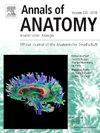雌性尤卡坦迷你猪骨盆大体神经解剖的外科和功能方法。
IF 2
3区 医学
Q2 ANATOMY & MORPHOLOGY
引用次数: 0
摘要
尤卡坦迷你猪在脊髓损伤的研究中得到了广泛的应用。作为一种大型动物模型,它为开发新的更有效的治疗方法提供了独特的优势。成功的神经调节实验需要精确地进入中枢和周围神经结构,这取决于对地形解剖学和先进手术技术的透彻理解。目前的研究描述了女性尤卡坦迷你猪盆腔器官的地形,以及控制盆腔脏器的主要神经和分支的手术方法。8个尸体标本,5个用4%多聚甲醛固定,3个不固定,在立体显微镜下进行解剖。形成骨盆外侧和腹外侧壁的肌肉被识别出来。阴部神经由S2和S3组成,包括由S1和S2组成的盆腔外神经。腹下神经与盆腔神经(由S2干的内脏分支和S1和S3的两个吻合的内脏分支组成)在骨盆丛汇合,骨盆丛支配膀胱、尿道、阴道、直肠和阴蒂海穴组织的自主神经。总之,目前的解剖学和神经解剖学的描述提供了一个全面的了解,在雌性尤卡坦迷你猪的泌尿生殖和结直肠区域的结构解剖。本文章由计算机程序翻译,如有差异,请以英文原文为准。
A surgical and functional approach to the pelvic gross neuroanatomy of the female Yucatan minipig
The Yucatan minipig is gaining widespread use in studies focused on spinal cord injury. As a large animal model, it offers unique advantages for developing novel and more effective therapies. Successful neuromodulation experiments require precise access to central and peripheral neural structures, which depends on a thorough understanding of topographical anatomy and advanced surgical techniques. The current study describes the topography of the pelvic organs in the female Yucatan minipig, as well as a surgical approach to the principal nerves and branches controlling the pelvic viscera. Eight postmortem specimens, five fixed with 4 % paraformaldehyde and three non-fixed, were used to perform dissections under stereoscopy. Muscles that form the lateral and ventrolateral walls of the pelvis were identified. The pudendal nerve, formed by S2 and S3 contributions, includes an extrapelvic component formed by S1 and S2 contributions. The hypogastric nerve converged with the pelvic nerve (formed by the splanchnic branch of the S2 trunk and two anastomotic splanchnic branches from S1 and S3) at the pelvic plexus which supplies the autonomic innervation of the urinary bladder, urethra, vagina, rectum, and cavernous tissue of the clitoris. Together, the current anatomical and neuroanatomical descriptions provide a comprehensive understanding of the structural anatomy of the urogenital and colorectal regions in the female Yucatan minipig.
求助全文
通过发布文献求助,成功后即可免费获取论文全文。
去求助
来源期刊

Annals of Anatomy-Anatomischer Anzeiger
医学-解剖学与形态学
CiteScore
4.40
自引率
22.70%
发文量
137
审稿时长
33 days
期刊介绍:
Annals of Anatomy publish peer reviewed original articles as well as brief review articles. The journal is open to original papers covering a link between anatomy and areas such as
•molecular biology,
•cell biology
•reproductive biology
•immunobiology
•developmental biology, neurobiology
•embryology as well as
•neuroanatomy
•neuroimmunology
•clinical anatomy
•comparative anatomy
•modern imaging techniques
•evolution, and especially also
•aging
 求助内容:
求助内容: 应助结果提醒方式:
应助结果提醒方式:


